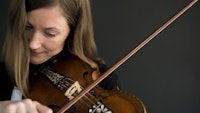Field of study: Performance Practice
Notto J.W. Thelle: Mixed-Initiative Music Making.

How can a mixed-initiative interactive music system aid human musicians in the initial ideation stage of music making?
Summary
A mixed-initiative user interface is one where both human and computer contribute proactively to a process. A mixed-initiative creative interface is the same principle applied in the domain of computational creativity support, such as in digital production of music or visual arts. The title “Mixed-Initiative Music Making” therefore implies a kind music making that puts human and computer in a tight interactive loop, and where each contributes to modifying the output of the other. Improvisational collective music making is often referred to as jamming. This thesis focuses on jamming-oriented approaches to music making, which takes advantage of the emergent novelty created by group dynamics.
The research question
Thelle's main question is: "How can a mixed-initiative interactive music system aid human musicians in the initial ideation stage of music making?"
Theory and Methods
Starting from a vantage point of dynamical systems theory, Thelle has addressed this question by adopting a Research through Design approach within a methodological framework of triangulation between theory, observation, and design. The study has maintained a focus on the activity of collective music-making through four studies over a period of two years, where the gradual development of a mixed-initiative interactive music system has been informed by findings from these studies. The first study is a focus group with musicians experienced in collective music making, where the goal was to establish commonalities in musical interaction and idea development with a focus on viable conceptual frameworks for subsequent studies. The second study is a case study of two improvising musicians engaged in an improvised session. They were separated into two rooms, and could only communicate instrumentally or through preset commands on a computer screen. The session was analysed in terms of how the musicians dynamically converged and diverged, and thus created musical progression. In the third study, several musicians were invited to jam with a prototype of an interactive music system. Unbeknownst to them, they had been recruited to a Wizard of Oz study—behind the scenes was a human keyboard player pretending to be a computational agent. The purpose of this arrangement was to obtain empirical data about how musicians experience co-creativity with a perceived computational agent before the implementation of the computational agent had begun in earnest. In the final study, two different implementations of a mixed-initiative interactive music system are developed for a comparative user study, where the tradeoff between user control and system autonomy was a central premise.
Findings
Combined, the studies show that a mixed-initiative interactive music system offers musicians freedom from judgement and freedom to explore their own creativity in relation to an unknown agency. Social factors make these kinds of freedom difficult to attain with other musicians. Hence, playing with interactive music systems can lead to different kinds of musical interaction than can be achieved between people. An acceptance of machine aesthetics may lead to surprising creative results. Repeated exposure to mixed-initiative interactive music systems could help cultivate attitudes that are valuable for collective music-making in general, such as maintaining a process-oriented approach and accepting the loss of idea ownership.
The dissertation
Title: Mixed-initiative music making. Collective agency in interactive music systems.
The dissertation is a monograph, and it is written in English.
Les også
Articles relevant
Published: Jul 12, 2019 — Last updated: Dec 18, 2025


